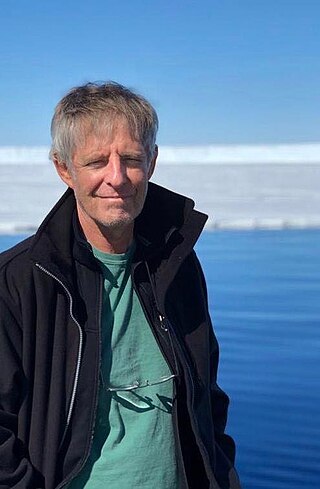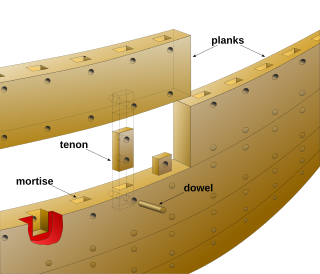
Atlantis is a fictional island mentioned in Plato's works Timaeus and Critias as part of an allegory on the hubris of nations. In the story, Atlantis is described as a naval empire that ruled all Western parts of the known world, making it the literary counter-image of the Achaemenid Empire. After an ill-fated attempt to conquer "Ancient Athens," Atlantis falls out of favor with the deities and submerges into the Atlantic Ocean. Since Plato describes Athens as resembling his ideal state in the Republic, the Atlantis story is meant to bear witness to the superiority of his concept of a state.

Maritime archaeology is a discipline within archaeology as a whole that specifically studies human interaction with the sea, lakes and rivers through the study of associated physical remains, be they vessels, shore-side facilities, port-related structures, cargoes, human remains and submerged landscapes. A specialty within maritime archaeology is nautical archaeology, which studies ship construction and use.

The keel is the bottom-most longitudinal structural element of a watercraft. On some sailboats, it may have a hydrodynamic and counterbalancing purpose as well. The laying of the keel is often the initial step in constructing a ship. In the British and American shipbuilding traditions, this event marks the beginning date of a ship's construction.

Kyrenia is a 4th-century BC ancient Greek merchant ship that sank c. 294 BC.

Association was a 90-gun second-rate ship of the line of the Royal Navy, launched at Portsmouth Dockyard in 1697. She served with distinction at the capture of Gibraltar, and was lost in 1707 by grounding on the Isles of Scilly in the greatest maritime disaster of the age. The wreck is a Protected Wreck managed by Historic England.

A foresail is one of a few different types of sail set on the foremost mast (foremast) of a sailing vessel:
Christopher Ralph Chippindale, FSA is a British archaeologist. He worked at the Museum of Archaeology and Anthropology from 1988 to his retirement in 2013, and was additionally Reader in Archaeology at the University of Cambridge from 2001 to 2013.
The Antikythera wreck is a Roman-era shipwreck dating from the second quarter of the first century BC.
Keith Muckelroy (1951-1980) was a pioneer of maritime archaeology. Instead of the traditional particularist or historiographic approach used by maritime archaeologists, Muckelroy's ideas were new to the field, influenced by the prehistoric and analytical archaeology he learned under Grahame Clark and David Clarke at Cambridge, the tenets of processual archaeology gaining traction in the U.S., and his own experiences on shipwreck sites in British waters, notably the 1664 Dutch East Indiaman Kennemerland, several Spanish Armada wrecks, and the Mary Rose.
Franck Goddio is a French underwater archaeologist who, in 2000, discovered the city of Thonis-Heracleion 7 km (4.3 mi) off the Egyptian shore in Aboukir Bay. He led the excavation of the submerged site of Canopus and of the ancient harbour of Alexandria, including Antirhodos Island. He has also excavated ships in the waters of the Philippines, significantly the Spanish galleon San Diego.

Mensun Bound is a British maritime archaeologist born in Stanley, Falkland Islands. He is best known as director of exploration for two expeditions to the Weddell Sea which led to the rediscovery of the Endurance, in which Sir Ernest Shackleton and a crew of 27 men sailed for the Antarctic on the 1914–1917 Imperial Trans-Antarctic Expedition. The ship sank after being crushed by the ice on 21 November 1915. It was rediscovered by the Endurance22 expedition on 5 March 2022.
Edgerton Alvord Throckmorton, known as Peter Throckmorton, was an American photojournalist and a pioneer underwater archaeologist.

George Fletcher Bass was an American archaeologist. An early practitioner of underwater archaeology, he co-directed the first expedition to entirely excavate an ancient shipwreck at Cape Gelidonya in 1960 and founded the Institute of Nautical Archaeology in 1972.
Ancient Black Sea shipwrecks found in the Black Sea date to Antiquity. In 1976, Willard Bascom suggested that the deep, anoxic waters of the Black Sea might have preserved ships from antiquity because typical wood-devouring organisms could not survive there. At a depth of 150m, the Black Sea contains insufficient oxygen to support most familiar biological life forms.

Charles T. Meide Jr., known as Chuck Meide, is an underwater and maritime archaeologist and currently the Director of LAMP, the research arm of the St. Augustine Lighthouse & Maritime Museum located in St. Augustine, Florida. Meide, of Syrian descent on his father's side, was born in Jacksonville, Florida, and raised in the adjacent coastal town of Atlantic Beach. He earned BA and MA degrees in Anthropology with a focus in underwater archaeology in 1993 and 2001 from Florida State University, where he studied under George R. Fischer, and undertook Ph.D. studies in Historical Archaeology at the College of William and Mary starting the following year.

Honor Frost was a pioneer in the field of underwater archaeology, who led many Mediterranean archaeological investigations, especially in Lebanon, and was noted for her typology of stone anchors and skills in archaeological illustration.
The Society for Underwater Historical Research (SUHR) was an amateur maritime archaeology organisation operating in South Australia (SA). It was formed in 1974 by recreational scuba divers and other persons to pursue an interest in maritime archaeology and maritime history. The SUHR was renamed as the South Australian Archaeology Society in March 2012 as part of a plan to expand its activities beyond maritime archaeology to include other archaeological disciplines.

The Maritime Silk Road or Maritime Silk Route is the maritime section of the historic Silk Road that connected Southeast Asia, East Asia, the Indian subcontinent, the Arabian Peninsula, eastern Africa, and Europe. It began by the 2nd century BCE and flourished until the 15th century CE. The Maritime Silk Road was primarily established and operated by Austronesian sailors in Southeast Asia who sailed large long-distance ocean-going sewn-plank and lashed-lug trade ships. The route was also utilized by the dhows of the Persian and Arab traders in the Arabian Sea and beyond, and the Tamil merchants in South Asia. China also started building their own trade ships (chuán) and followed the routes in the later period, from the 10th to the 15th centuries CE.

Phoenician joints is a locked mortise and tenon wood joinery technique used in shipbuilding to fasten watercraft hulls. The locked mortise and tenon technique consists of cutting a mortise, or socket, into the edges of two planks and fastening them together with a rectangular wooden knob. The assembly is then locked in place by driving a dowel through one or more holes drilled through the mortise side wall and tenon.

War at Sea: A Shipwrecked History from Antiquity to the Twentieth Century is a book by American maritime archaeologist James P. Delgado, published in 2019 by Oxford University Press. The book explores naval warfare through the lens of shipwrecks, spanning over three thousand years of history from ancient civilizations to the Cold War. Drawing on decades of Delgado's own research and underwater explorations, the book present a global perspective on the development of naval warfare, emphasizing the role of archaeology in uncovering the often-overlooked human stories behind these sunken vessels.











